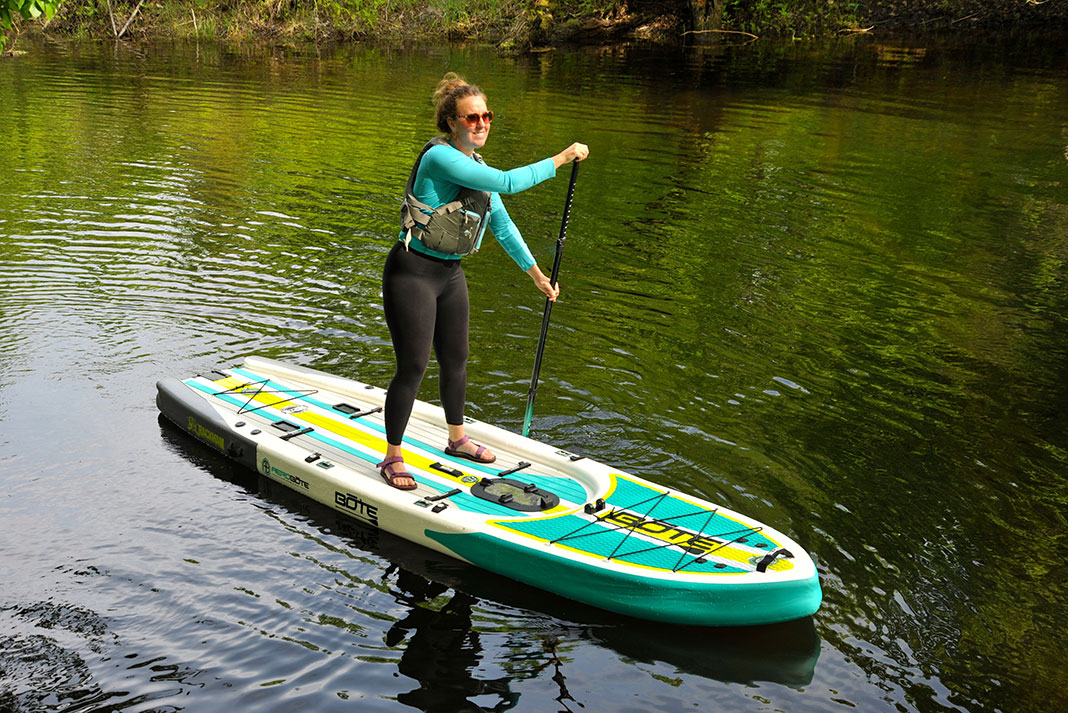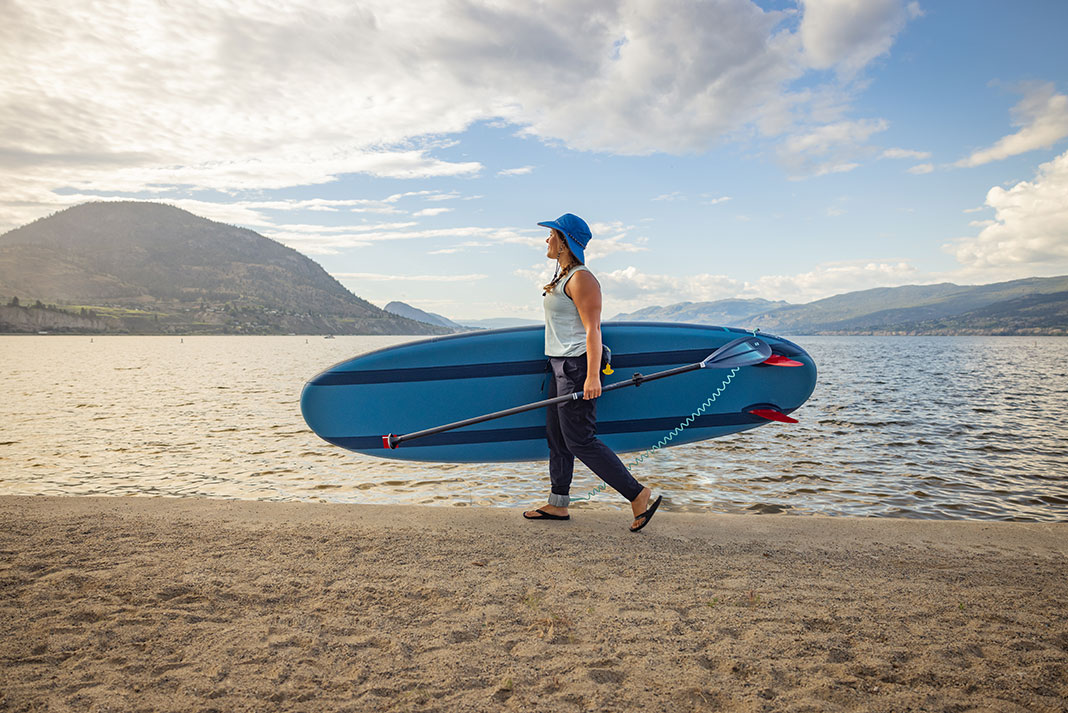Inflatable standup paddleboards have revolutionized the sport of SUP. They store in oversized luggage bags to transport, often include a pump and breakdown paddle, and provide ease in the ability to access arguably the most relaxing form of paddling there can be. Oh, and there’s no shortage of budget-friendly options out there. When I first set eyes on an inflatable years ago, I thought they were a gimmick, and wondered who would want one in place of a fiberglass layup. I shake my head today at my shortsightedness and lack of imagination.
This is because it is not convenience alone responsible for the astronomic rise of inflatable paddleboards. They would be no fun at all if it weren’t for their continually improving performance, thanks to the competitive race in innovations of their construction. As manufacturing, new materials, and layup patterns keep advancing, inflatables continue their march toward matching the performance of hard standup paddleboards.
What this all means is the inflatable paddleboard is no longer just the choice of beginners. Thanks to these advances, 12- and 14-foot boards have even made it to the SUP race scene. And the durability of inflatables has made them the go-to board for those SUPing whitewater.
The popularity of these boards has also led to an overwhelming flood of options to choose from. If you stick to a few key points in shape and construction you’ll likely end up with a board you’ll enjoy, but to help guide the search, the Paddling Mag team including myself have tested the best inflatable paddleboards available across every category there is, and provided here a selection of our favorites.
The best inflatable paddleboards for 2025: Our top picks
- Best all-around: NRS Jukdo 108
- Best budget board: Retrospec Weekender Tour 11’6”
- Most stable paddleboard for beginners: Sea Gods Diatom 10’6”
- Best touring board: Red Equipment Voyager 12’6”
- Best inflatable paddleboard-kayak combo: ISLE Explorer Pro Package
- Best Whitewater SUP: Hala Atcha 86
- Best Fishing paddleboard: BOTE Rackham Aero
Best all-around inflatable paddleboards
NRS Jukdo 108
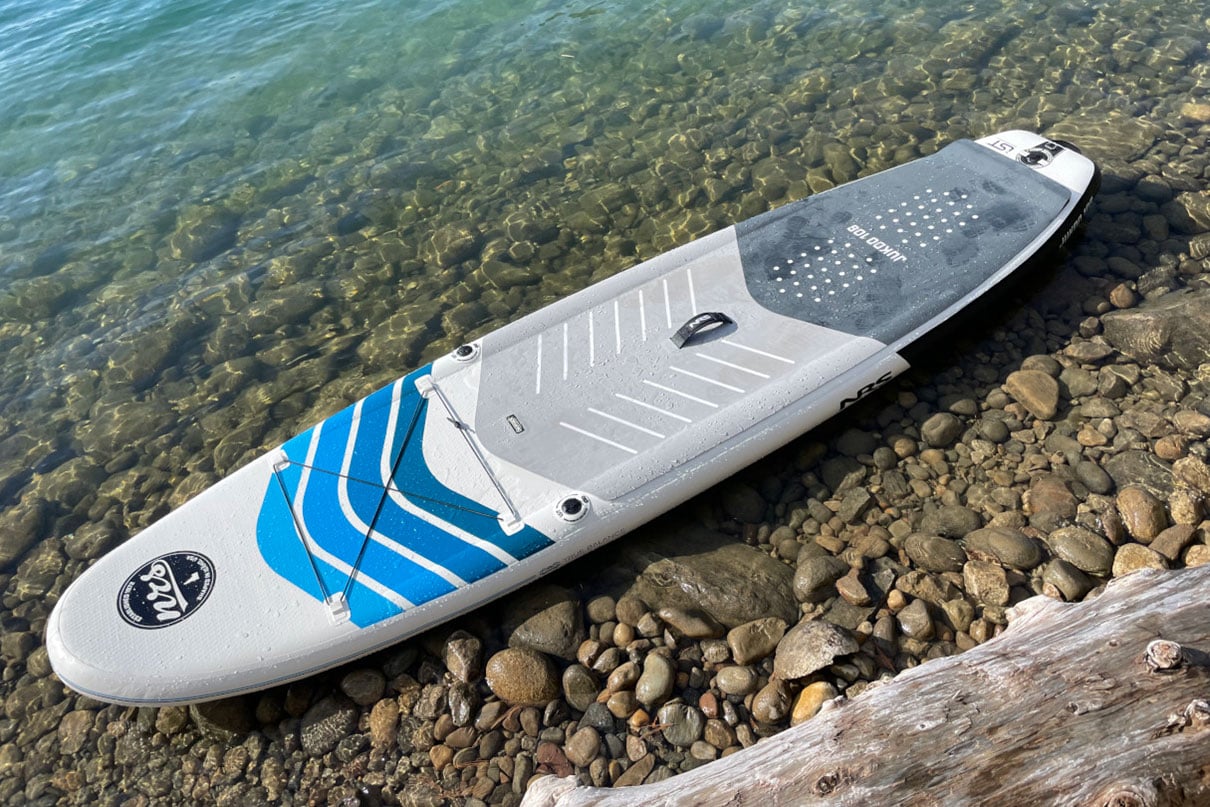
NRS Jukdo 108 Specs
Length: 10’8”
Width: 34”
Thickness: 5”
Weight: 24 lbs
Capacity: 250 lbs
MSRP: $995 USD
nrs.com
Buy from:
Why I love it
The Jukdo is NRS’s statement an all-around inflatable can be much more than the cookie-cutter shape of a round nose and 30-some-inch wide board. They accomplish this mostly with their Integrated Shaping Technology (IST), which uses multiple air chambers to give the inflatable unique shapes usually found on rigid boards.
What this IST looks like on the Jukdo is a dropped deck allowing NRS to lower your standing height without sacrificing the board’s volume—translation, a lower position increases your stability, especially when the river or lake gets wavey. Paddling Magazine media strategist Brenna Kelly tested the Jukdo on the waters surrounding Revelstoke, B.C., and after using the board, expressed that the raised deck edges allowing the dropped standing position are what separate the Jukdo from any other all-around inflatable.
NRS also utilized IST to create a channeled hull, similar to what we see on pontoon-style kayak hulls. This channeled hull provides a smooth paddle on flat water and increases the surface area of board on water.
The Jukdo includes a set of three all-around fins and a touring fin, a well-built dual-action pump with a setting for high-pressure inflation, and a burly travel bag.
Reasons to buy
- IST-developed dropped deck for increased stability
- Channeled hull for smooth flatwater paddling
- Z/Blend Core construction is 20 percent stiffer yet 15 percent lighter than previous NRS board generations
- Options for three-fin or single-fin setup included
Consider another if
- You prefer a traditionally decked inflatable
- Are seeking a board specific to touring or whitewater
Bottom line
The Jukdo is an all-around inflatable paddleboard anyone will enjoy whether you are a beginner or advanced paddler. It won Paddling Magazine’s 2024 Industry Awards for the SUP category thanks in no small part to its innovations in the space.
Red Equipment Ride 10’6” MSL
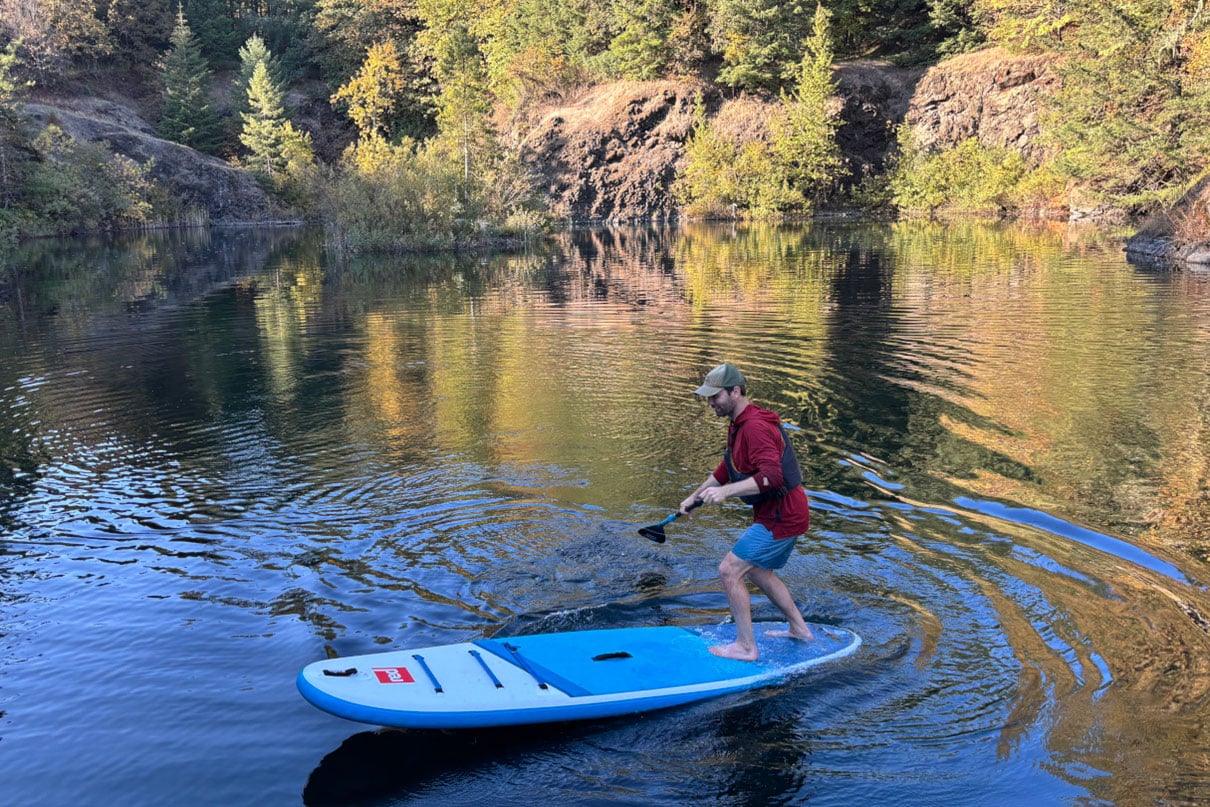
Red Equipment Ride 10’6” MSL Specs
Length: 10’6”
Width: 32”
Thickness: 4.7”
Weight: 22 lbs
Volume: 245 L
Capacity: 220 lbs
MSRP: $949 USD
red-equipment.us
Buy from:
RED EQUIPMENT AMAZON BACKCOUNTRY
Why I love it
With the number of inflatable boards I’ve paddled, I appreciated Red’s Ride 10’6” the moment I stepped onto it. The deck height at 4.7 inches sits a half to an inch lower than many other all-around boards, and at 32 inches wide, it’s a little narrower as well. I wondered if this would make the Ride feel less stable or spongy, but the flat bottom still provides plenty of stability, and when I jumped on the board, the sense I felt was more connected to the water. Beyond the paddler positioning, the board also glides well and makes smooth arching turns thanks to the rounded tail.
This may sound like an odd detail to point out, but the Ride’s deck pad is one of the most comfortable I’ve ever stood on. When the name of the sport is standup, and you plan to spend hours on your feet, this says a lot.
The Ride 10’6” also has fixed permanent twin fins, which is not the case for many boards. They are a durable and bendable construction to avoid damage, but this also means they do not detach or swap for other fin styles. It’s helpful not having to keep track of fins, nuts and bolts, but it is likely a love-it-or-hate-it feature of the Ride.
Reasons to buy
- Narrower and with less height than most others in the class for a connected-to-water feel
- Monocoque Structural Laminate (MSL) can be inflated to 22 PSI yet feels stiff even at lower levels of inflation thanks to reinforced composite coating
- Incredibly comfortable EVA deck pad
- Individual bungee straps for deck storage
- Built-on twin fin setup means you’ll never have to screw keep track off or screw in fins
Consider another if
- You prefer the feel of a wider or higher Inflatable SUP
- The fixed fins are not your jam
- You want a longer touring-specific board or a rockered board for running whitewater
Bottom line
Red Equipment builds exceptional inflatable boards, and you can feel the difference in the Ride compared to other similar-looking all-arounders the moment you step onto it.
Best budget inflatable paddleboard
Retrospec Weekender Tour 11’6”
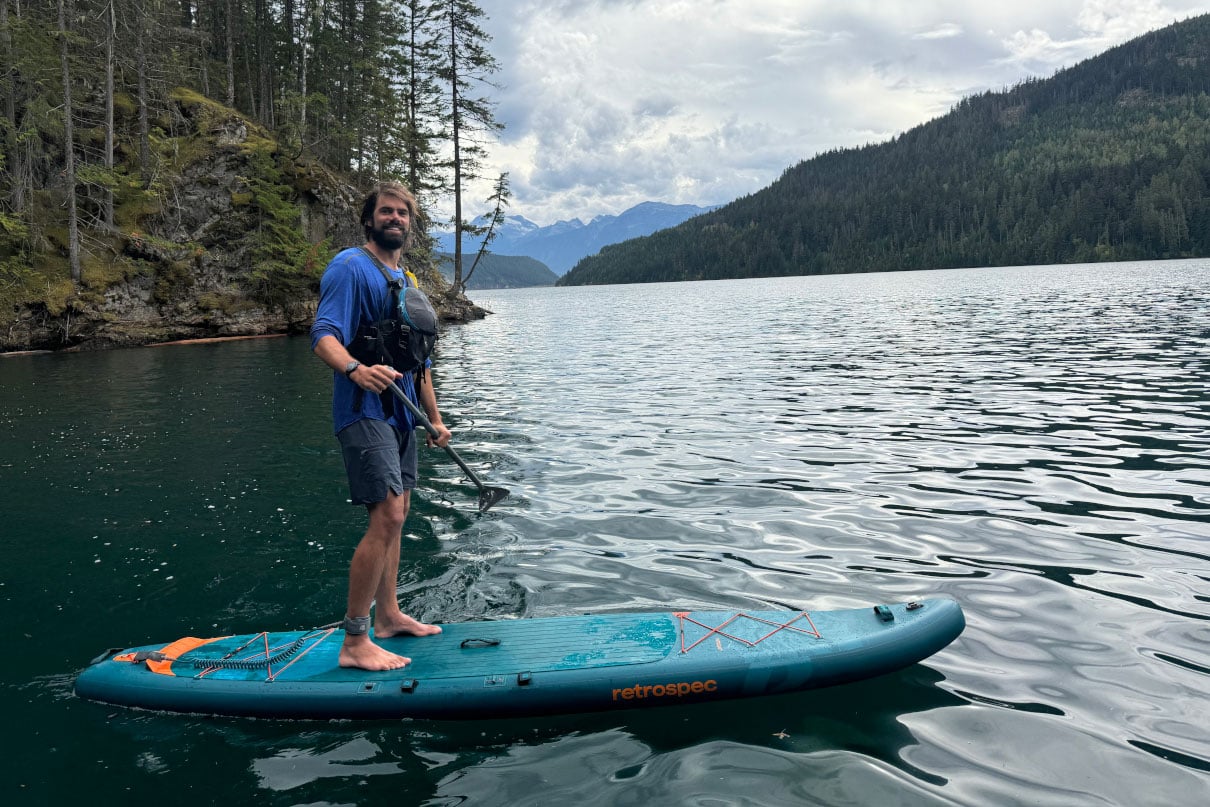
Retrospec Weekender Tour Specs
Length: 11’6”
Width: 32”
Thickness: 6”
Weight: 23.5 lbs
Capacity: 300 lbs
MSRP: $349 USD
retrospec.com
Buy from:
Why I love it
You don’t need to drop a month’s rent to buy a standup paddleboard, there is a whole list of brands making solid inflatables at a low cost. What you do want to be sure of when you’re buying a low cost board is it inflates to a solid pressure and holds up well with use. It helps to buy a budget board from a brand others have come to trust, such as Retrospec.
Retrospec is a recreation equipment company found in stores like Play It Again Sports and Scheels, or online on Amazon. Their Weekender Tour is an 11’6” board on par with other popular models. Paddling Magazine publisher Cristin Plaice took the Weekender Tour to scenic spots around Revelstoke and found it to be an enjoyable board at a low cost.
The Weekender also includes a paddle, fins, pump, repair kit, and a leash for lakes and open coastal waters. Everything you need to go paddleboarding—except for a life jacket—for under $300.
Reasons to buy
- Low price
- In addition to the usual accessories it Includes a paddle and leash
Consider another if
- You have the budget for a higher-quality construction
- Seeking a board geared specifically toward touring or whitewater
Bottom line
The Weekender Tour is a budget-friendly, enjoyable, and reliable inflatable paddleboard.
Best for touring and fitness
Red Equipment Voyager 12’6”
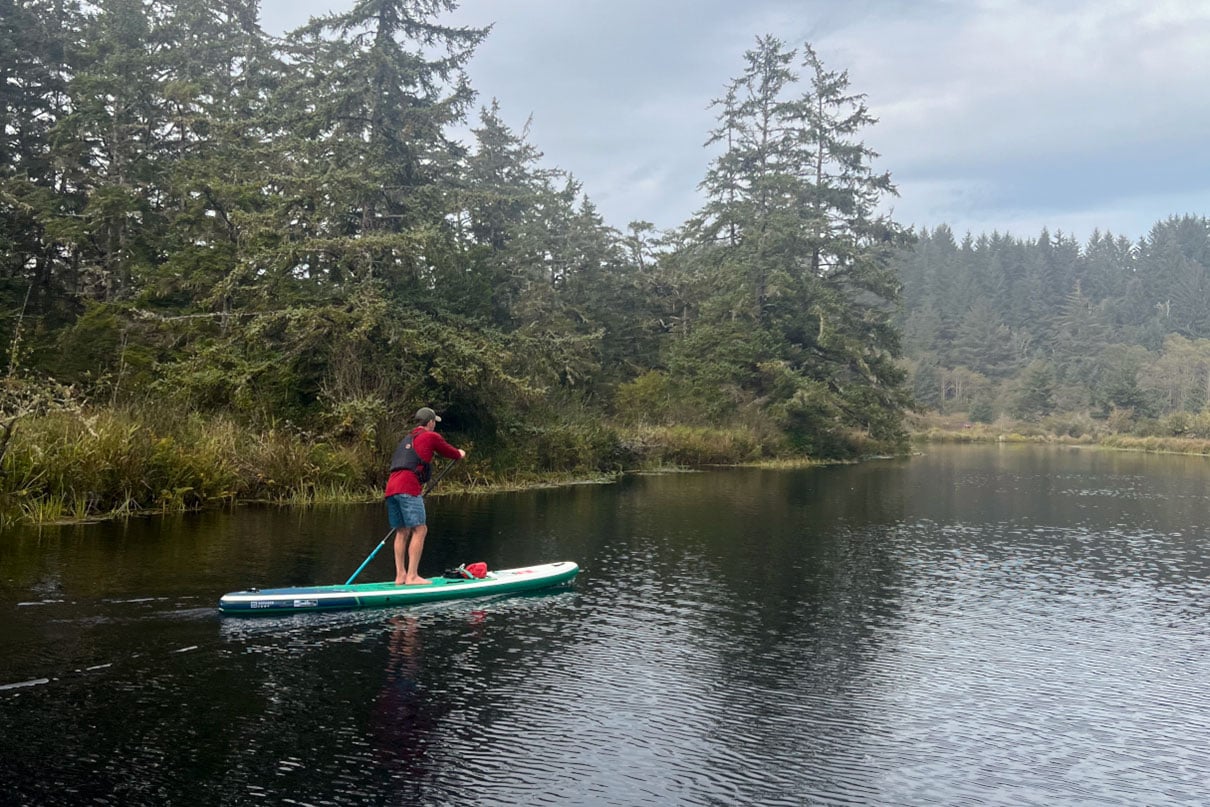
Red Equipment Voyager 12’6” Specs
Length: 12’6”
Width: 32”
Thickness: 5.9”
Weight: 30.35 lbs
Volume: 361 L
Capacity: 330 lbs
MSRP: $1,299 USD
red-equipment.us
Buy from:
Why I love it
The Red Voyager is a stable inflatable still capable of covering ground. It’s 32 inches wide and six inches in thickness, accounting for much of the stability in a touring design. The Voyager has a rounded nose and tail. The V-hulled bottom on the nose—which they’ve accomplished in the tapering of their drop stitch pattern—cuts through the water and chop for a smooth glide.
For the Voyager, Red also has insertable plastic rods called their Rocker Stiffening System (RSS). As high pressured as an inflatable SUP can be at 15 to 20-some psi, once you reach a length like 12 feet any inflatable board is still going to lose some efficiency with a bit of tacoing to occur. Red’s RSS counteracts this with the plastic stringers you can add to the rails.
There are other solid details on the Voyager as well. The EVA deck pad from Red is one of my favorites of any inflatable to spend hours standing on. I also appreciate the wider individual bungee straps over the commonplace thin bungee cord and wish more SUP brands would take note of improving deck storage.
Reasons to buy
- Wide, voluminous touring paddleboard for increased stability, higher weight paddlers, or lugging more gear
- V-hulled nose cuts through chop
- RSS plastic rods increase stiffness of inflatable touring board
- Comfortable deck pad
- Individual bungee-strap deck storage system
- Twin fin setup
Consider another if
- Speed outweighs priority over stability
- You prefer a single-fin setup
Bottom line
If you want a stable touring board or the ability to carry more gear for a SUP expedition, the Voyager is a tough inflatable to beat.
NRS Clipper 126
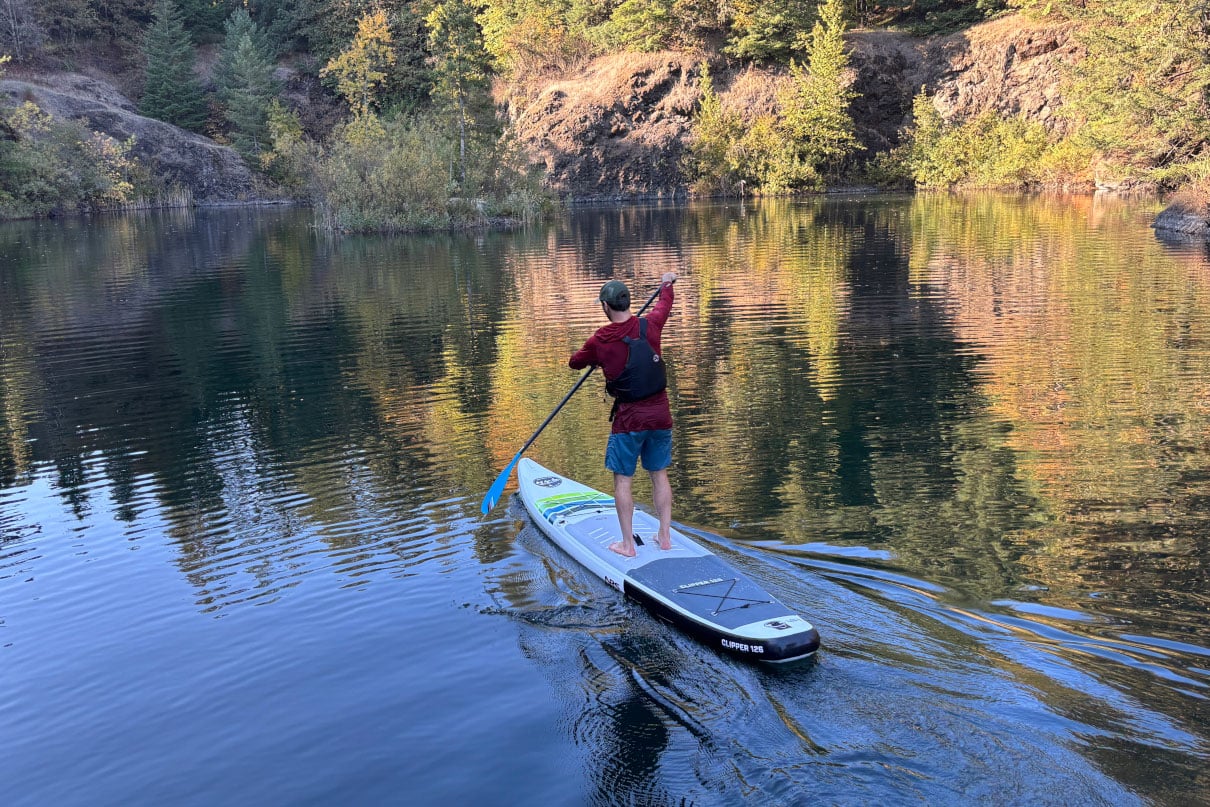
NRS Clipper 126 Specs
Length: 12’6”
Width: 29”
Thickness: 6”
Weight: 24.2 lbs
Volume: 319 L
Capacity: 235 lbs
MSRP: $945 USD
nrs.com
Buy from:
Why I love it
The Clipper 126 gets cruising in a way I expect from a composite touring board, not an inflatable. In the same way NRS utilizes the Integrated Shaping Technology and Z/Blend Core material to make a more detailed and rigid shape in the Jukdo mentioned earlier, they’ve done so with the Clipper. In my view, the result is more positively staggering on this touring board than on their all-around board.
With the IST details, NRS has accomplished two major design components that put the Clipper in an upper class of inflatable touring boards.
The dropped deck lowers the paddler position, something we see on composite touring and race boards. This increases stability for the paddler and allows board designers to pull in the width, creating a narrower, faster board.
The second is the V-hull at the bow. By having a wedged, peaked bow, the Clipper cuts through water and wake rather than slapping at it, making the board more efficient.
When designers are working with foam and composite rigid layups, these components are commonplace on touring boards, but on inflatables, it’s a rare few paddleboard brands with the tech capable of such features. NRS and the Clipper 126 are one of the few pulling ahead of the pack.
Reasons to buy
- Integrated Shaping Technology allows for details usually found on a rigid paddleboard, including a dropped deck standing position and V-hull at the bow
- Fast hull with good glide
- Single-fin setup and includes both a standard touring fin and a raked-back grass fin for the shallows
- Fore and aft bungee deck storage to load up for an overnight trip
- Bow and stern rocker release the ends to give the board some maneuverability
Consider another if
- You prefer a flat deck space in comparison to the dropped deck
- You want a wider board for more initial stability—in which case the NRS also offers the 33’ wide Clipper 126W
Bottom line
The Clipper 126 pushes the boundaries of what an inflatable touring paddleboard can be, and the result rips.
Most stable inflatable paddleboard for beginners
Sea Gods Diatom 10’6”
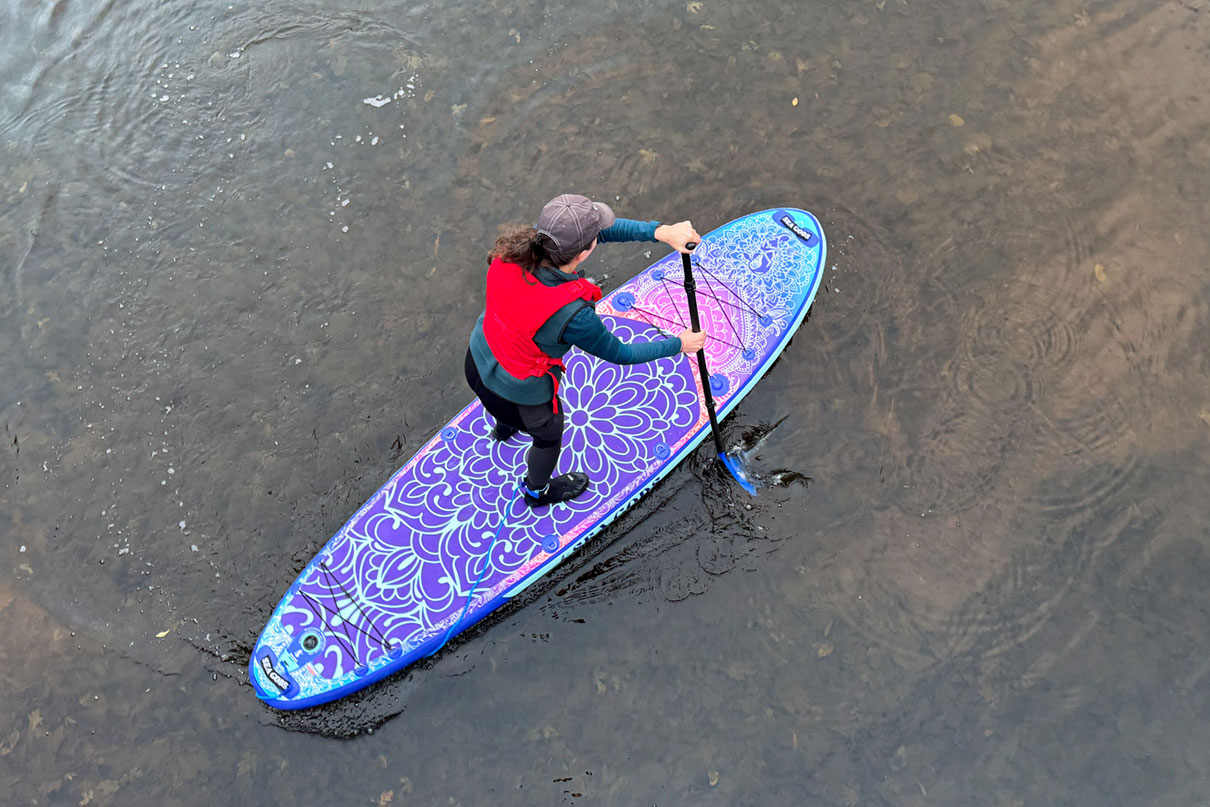
Sea Gods Diatom Specs
Length: 10’6”
Width: 34”
Thickness: 6”
Weight: 21 lbs
Volume: 334 L
Capacity: 350 lbs
MSRP: $1,749 USD
seagods.com
Buy from:
Why I love it
The Diatom from Sea Gods addresses a key need in paddleboarding—feeling stable and building confidence. The Diatom accomplishes this in the form of a 34-inch wide board. But it’s not the widest point alone which increases stability. It carries this width in a more gradual taper toward the nose and tail, staying wide for longer, which also translates to its big volume of 334 liters. A big, flat surface area creates a stable paddleboard ideal for beginners, higher-weight paddlers, or even those who want a board for SUP yoga. A more stable board is usually a tradeoff for decreased speed, but the Diatom still moves along fine for those on casual outings.
Editor-in-chief Kaydi Pyette tested the Diatom on the waters surrounding Toronto. “Balancing feels effortless, and tracking is smooth, thanks to its single full-size fin. While it’s not the stiffest inflatable I’ve paddled, it’s close,” Pyette shared in approval of the Diatom.
Sea Gods’ boards are attractive inflatables for more than thoughtful shapes. They are also decorated in the work of artist collaborations. “Sea Gods make some of the most stunning inflatable boards on the market,” Pyette also said. “Right off the bat, the Diatom wowed me with its intricate design, created by artist Jamie Locke. This eye-catching artwork is a guaranteed conversation starter—folks at the launch often stop to ogle this board.”
Reasons to buy
- Wide, stable inflatable paddleboard
- A solid choice for beginners, higher-weight paddlers and SUP yoga
- Unique artwork collaborations
- In addition to the usual accessories it includes paddle, leash and a ground cloth to keep your board clean when rolling up
Consider another if
- A faster board is needed to cover miles
- Budget is a factor
Bottom line
Stable is the name of the game with the stunningly designed Sea Gods Diatom.
Best inflatable paddleboard-kayak combo
ISLE Explorer Pro SUP-Kayak Bundle
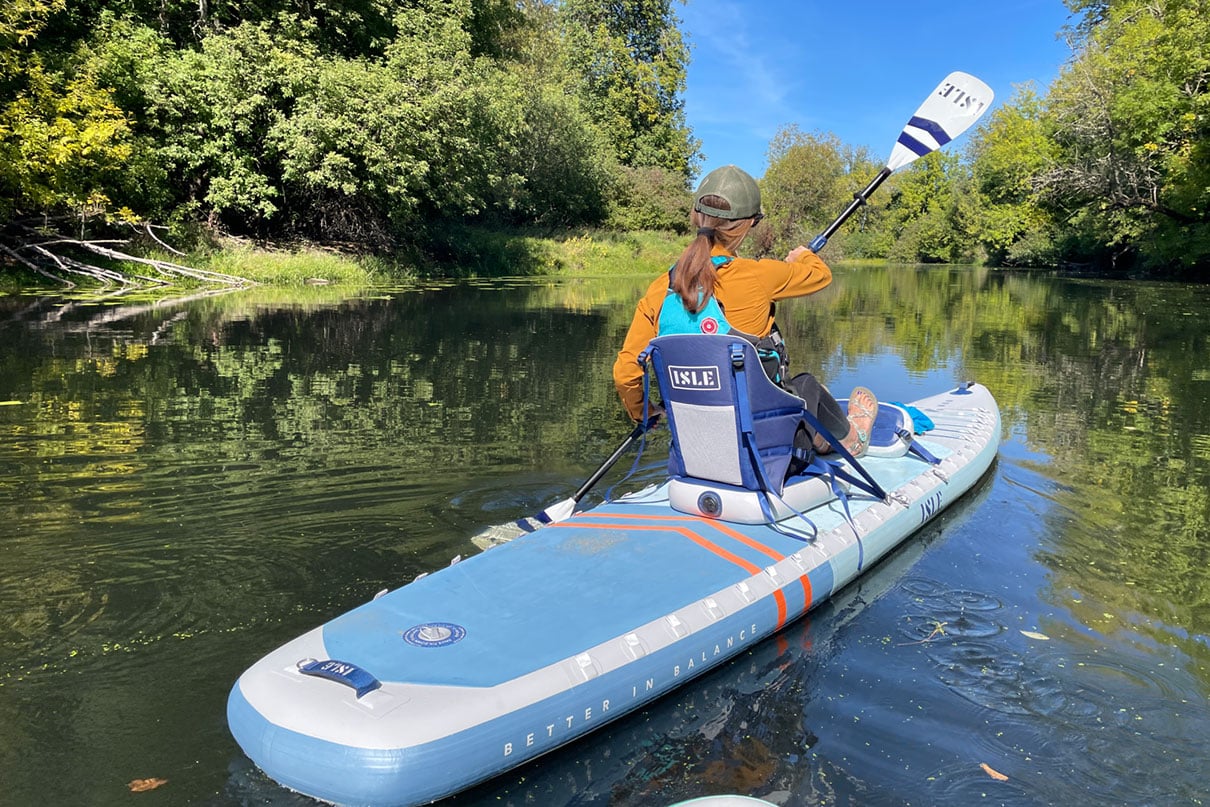
ISLE Explorer Pro Specs
Length: 12’
Width: 31.5”
Thickness: 6”
Weight: 23 lbs
Volume: 50 lbs
Capacity: 330 L
MSRP: $1,495 USD
islesurfandsup.com
Buy from:
Why I love it
When inflating ISLE’s Explorer Pro, I’ve had multiple strangers walk up to tell me what a great board it was. Among a sea of inflatables this is always a good first sign, but what I found more intriguing was they didn’t just say what a capable touring board it was. They walked up to tell me how much they loved it as a kayak. Up until then I’d always thought of the SUP-kayak hybrid as a value add. Throw in a cheap paddle and some seats and people will feel like they are getting more for their money. With the Explorer Pro you actually are getting three capable crafts, a touring iSUP, and either a solo or tandem recreational inflatable kayak.
ISLE walks the walk with their combo because the seat and footrest they include are well-designed. The lash points running down the entire length of the board allow the inflatable footpad to be placed wherever works best, and the kayak seat inflates to be solid, elevated, and comfortable. As a side note, having these lash points on the entire board is an underrated design component. You can strap gear just about anywhere and incorporate cam straps or accessory cord instead of the standard thin bungee cord found on most boards.
Let’s not forget, the Explorer Pro is a touring board first, and one of the most rigid inflatable boards out there thanks to the composite Infinity Fiber stringers which work similar to those wrist slap bracelets, letting the board roll up tight, but adding incredible rigidity when unfurled.
Reasons to buy
- Well-designed kayak paddleboard combo
- Up to three paddle crafts in one travel bag
- Bundle includes adjustable seats, footrests, and paddles you can configure for SUP or kayak (can also buy board without kayak setup)
- Capable 12-foot touring board
- Infinity Fiber acts as composite stringers to increase rigidity
Consider another if
- You’re looking for a traditional kayak
- You’re seeking a shorter or wider board
Bottom line
The Explorer Pro is a well-engineered SUP-kayak hybrid—a common sentiment at local boat launches.
Best for whitewater and river surfing
Hala Atcha 86
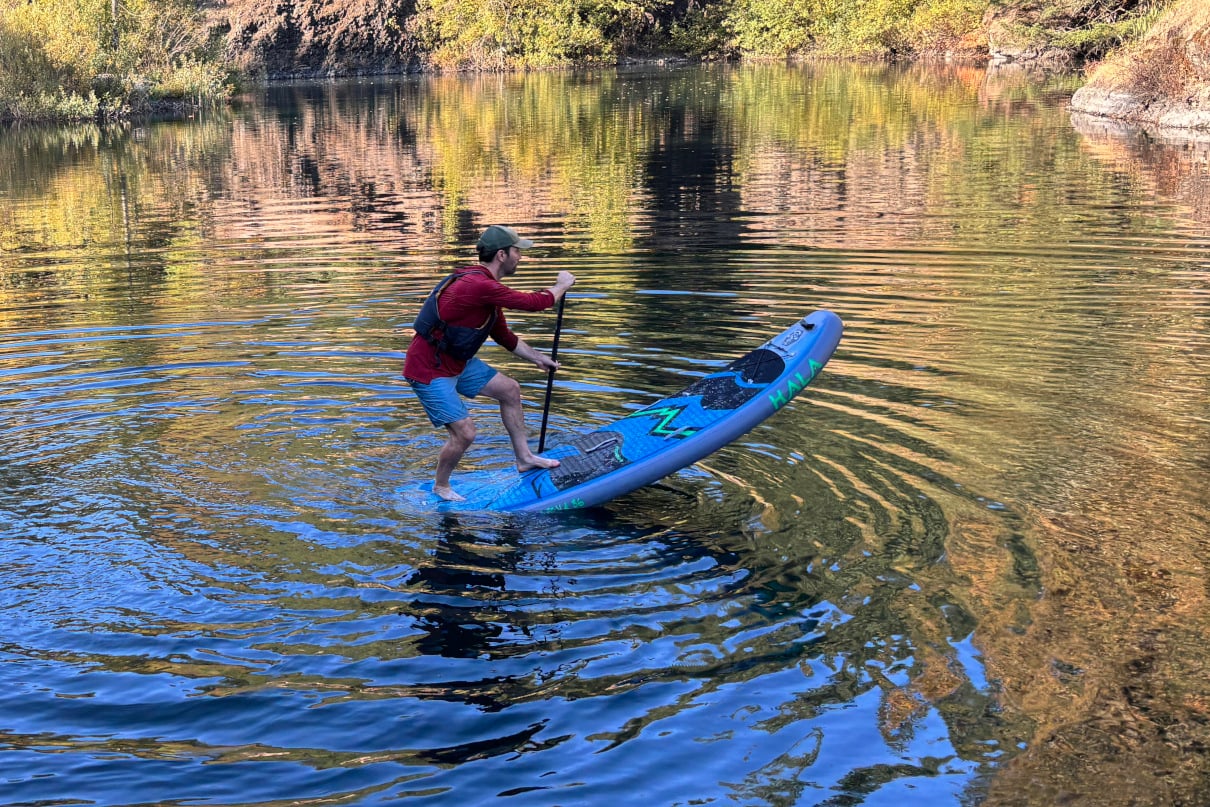
Hala Atcha 86 Specs
Length: 8’6”
Width: 34”
Thickness: 6”
Weight: 24 lbs
Volume: 269 L
Capacity: 250 lbs
MSRP: $1,199 USD
halagear.com
Buy from:
Why I love it
Riding the Hala Atcha 86 is like dropping into the river on a skateboard. The short 8’6” length, continuous rocker, peaked bow and swallow tail, wants to jump over features and shred across the face of a wave. And the thing is a blast to stand on end. Practicing pivots on the pond, I felt like a duck bobbing vertically.
There are also three more subtle features of the Atcha 86 I found well thought out for whitewater. The first is the indexed stomp pad in the center near tail, letting you know about how far back you are stepping to lift the nose. Next are the grab handles on the deck across from one another, which provide a good way to regain yourself when the sport turns into falldown paddleboarding. And the third is the three-fin setup with the longer, spring-loaded, retractable center fin Hala calls their Stompbox. File retractable fin under necessity for rocky rivers.
Reasons to buy
- Playful rocker blasts over features and keeps the nose up when surfing
- Easy to standup for pivot turns
- Multiple handles to regain composure post-wipeout
- Three-fin setup with center, spring-loaded Stompbox
Consider another if
- You want a board that is less party and more business on whitewater
- You seek initial stability and glide
- You plan to mostly paddle flatwater and dabble in class I and II rapids
Bottom line
The Hala Atcha 86 brings street-style skateboarding to the whitewater SUP scene.
Badfish Rivershred
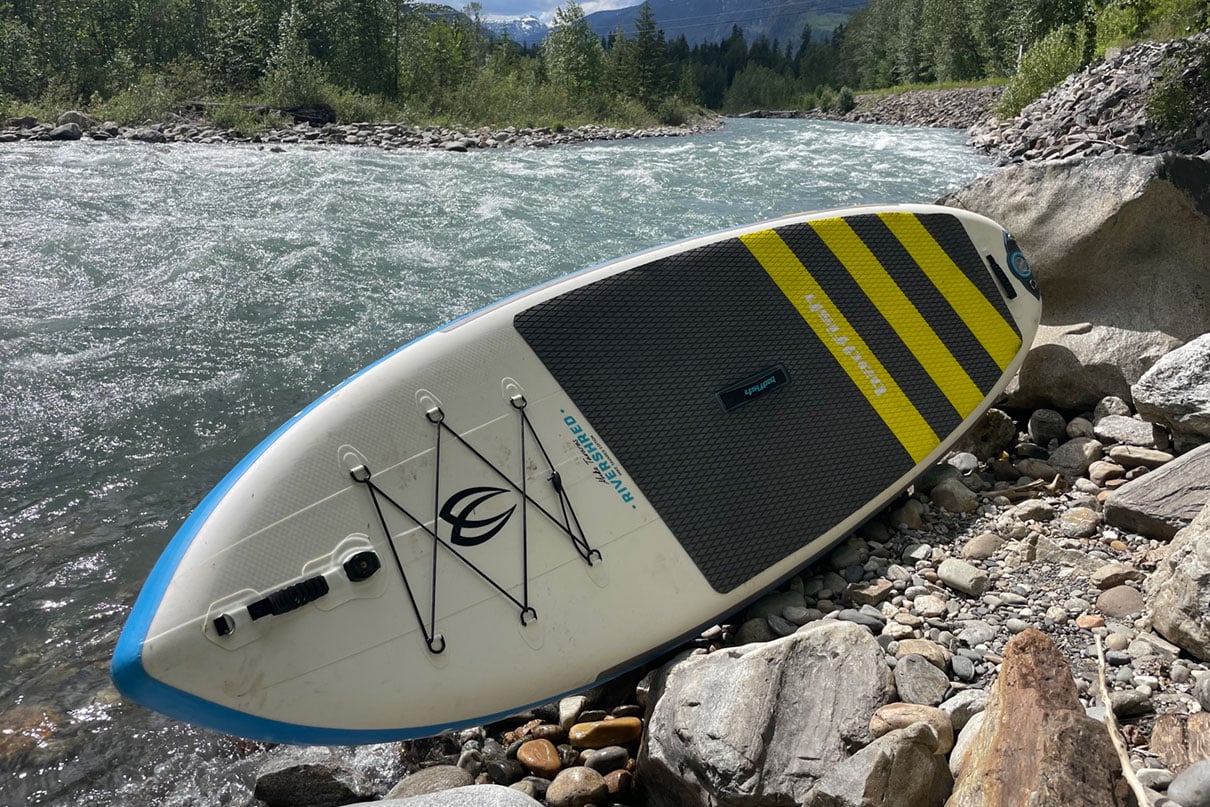
Badfish Rivershred Specs
Length: 9’6”
Width: 36”
Thickness: 6”
Weight: 32 lbs
Capacity: 300 lbs
MSRP: $999 USD
badfishsup.com
Buy from:
Why I love it
About the length of many popular river running kayak designs, the Rivershred is the inflatable paddleboard counterpart and rips its way along stretches of whitewater. Along with Hala, Badfish is one of few brands utilizing full rocker boards, which is a game changer on whitewater.
Paddling Mag media strategist and in-house whitewater SUPer Brenna Kelly had high praise for the Rivershred’s design. “The rocker makes gliding over waves and foam piles smoother because you go over instead of plowing through,” Kelly explained. “It also allows you to be more dynamic on a river wave, gaining speed into the trough without the nose diving. And you can initiate spins and grinds easier because less of your board rail is active on the face.”
Kelly also notes the reinforced layer of PVC on the rails, and centerline of the deck and base, which Badfish calls their ExoSkeleton, to increase the stiffness of the board and provide more of a rigid board responsiveness when making moves through a rapid or cutting across a wave face.
Reasons to buy
- 9’6” length with full rocker carries over waves and surfs well
- ExoSkeleton reinforced areas increase stiffness for rigid-like responsiveness
- Included flex fins keep the board tracking without breaking upon collisions with rocks
- Electric pump included with board
Consider another if
- You only plan to paddle whitewater occasionally
- You want a shorter, super-aggressive board for surfing
- You want a larger board with less rocker for more initial stability
Bottom line
The Rivershred is a solid choice for river running and surfing, with a full-rocker design that turns whitewater into a playground.
Best inflatable paddle board for fishing
BOTE Rackham Aero
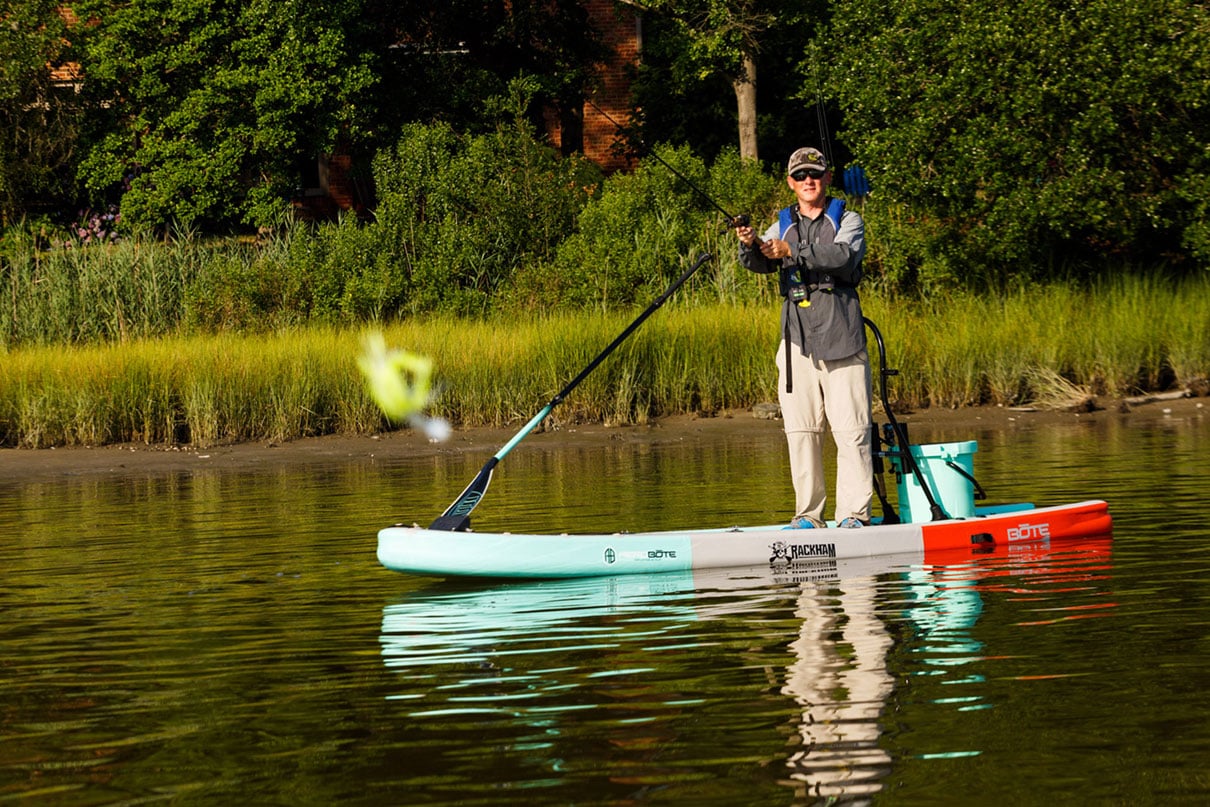
BOTE Rackham Aero Specs
Length: 12’4”
Width: 38”
Thickness: 7”
Weight: 45 lbs
Capacity: 400 lbs
MSRP: $1,649 USD
boteboard.com
Buy from:
Why I love it
Fishing from a SUP is a sightcaster’s game—an exciting way to cruise the coastal flats in search of tails or an alpine lake with vigilance for rising trout. Not only can you spot fish, but you put yourself in a position to let fly some phenomenal casts. This is until actually hooking a fish when the excitement turns spicy trying to avoid getting pulled into the drink. By having the right board SUP fishing is like having a sporty, mini-skiff. None may be as equipped for the task at the BOTE Rackham Aero.
The Rackham is a massive, stable platform to cast and fight fish from. But it is also designed with angler-minded addons. BOTE has included outfitting components, including a slot to stand a paddle while casting, accessory tracks in front of and around the paddler, magnetic storage to hold a lure or water bottle, and, best of all, the ability to build onto the board with their accessories including rod holders and board specific coolers—which can also serve as a seat just behind the paddler.
The Rackham Aero would be a fun setup if we stopped there, but it also has the ability to install their inflatable seats and pedal-drive system, giving it the ability to go from SUP-fishing rig to pedal fishing kayak.
Reasons to buy
- Built with SUP fishing in mind
- Stable platform to sight cast and fight
- Many add-on accessory options made specific for BOTE boards
- Can be set up as either a paddleboard or kayak
Consider another if
- You want a paddleboard with a smaller footprint
- Fishing from your SUP is a far second from the paddleboarding itself
Bottom line
The BOTE Rackham Aero inflatable board is a SUP-fishing machine.
Inflatable paddle board buying advice
There is a never-ending list of paddleboards available, and they range in price drastically. Do you have to spend a fortune on a paddleboard in order to have one you’ll enjoy? For most who just want to float on the lake or drift down your local river not at all. But like any other sport, as similar as one inflatable board looks from the next, you do get what you pay for. So what should you consider when choosing an inflatable board?
Choosing a paddleboard shape
The easiest place to start is with the shape. If you aren’t sure what you are searching for, an all-around shape resembling the classic surfboard look works well in a variety of general uses. They tend to have a wide, rounded nose, are around 32 inches at their widest point, and are between five to six inches thick—attributes that when combined with their flat bottom makes them relatively stable platforms. You could paddle miles on a lake or bay, cruise down the river, and even catch some small waves with one of these all-around recreational shapes.
Touring boards tend to have a pointed nose and a narrower shape. This makes them faster, but because they are narrower they feel less stable. They are great for covering miles on open water or where paddlers need to battle wind and tides.
Whitewater boards can look similar to an all-around board, but often have more aggressive rocker where the nose and tail are uplifted drastically. This helps with performance by letting paddlers lift the board over features or when surfing waves. On flat water though, this again makes the board feel less stable, and also does not glide in straight lines as well—this is by design to maneuver in rapids.
The dimensions of any board shape play a role as well. Length, width, and thickness throughout add up to the board’s volume. Higher volume provides more buoyancy. This doesn’t always equate to more stable. A touring board may have a higher volume than an all-around board, however if much of this volume occurs in its length, not width, it could be more stable compared to other touring boards, but not compared to an all-around board with a wider belly where the paddler stands. The length-to-width tradeoff provides a sense of the board’s priorities of speed and glide or stability. Without taking other details such as rocker into account, a wider board will be more stable, and a narrower board has more potential speed.
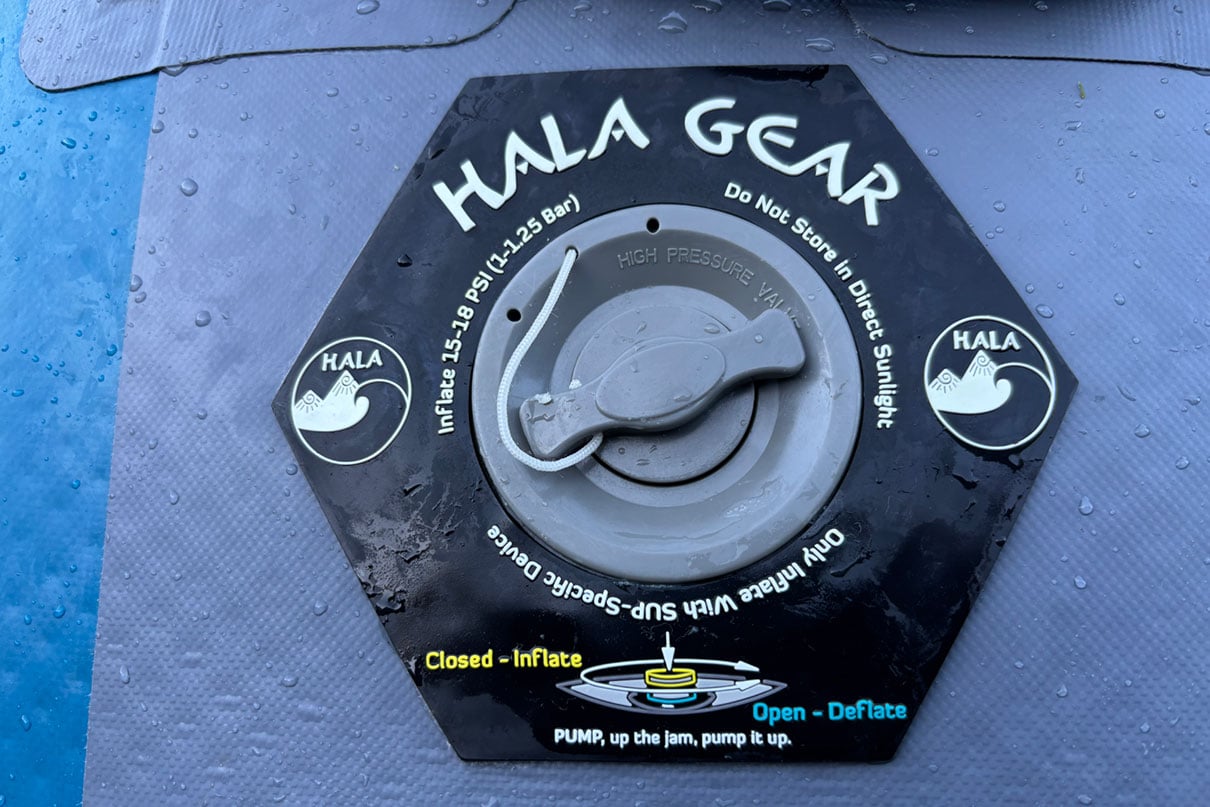
Considering terms like drop stitch and psi
Drop stitching and psi are terms thrown around in every conversation surrounding inflatable SUPs as well.
Drop stitching refers to the internal threads of the board, which allows its board-shape by not letting it balloon when inflated with air. This drop stitching is integral to these types of boards being able to exist.
Maximum psi, or pounds per square inch, as we are familiar with from other aspects of life whether it be a raft, bike or car tire, is how much air pressure a board can be inflated to. As an oversimplified rule, the higher the maximum psi a board can be inflated to, the more rigid it will be. The closer you can get to the feeling of standing on a board made of a solid material like fiberglass the better. A spongy paddleboard does not glide well at all, and it’s also more difficult to stand on. You want a paddleboard to be able reach 10 psi at a minimum, and some inflatables today can reach pressures beyond 20 psi. The drop stitch manufacturing process used, material layup, and bonding of materials all play a role in the psi a board can reach. As materials and design components—like embedded composites—advance, brands are also finding ways to make inflatable boards more rigid. It only takes one outing to see manually pumping to high psi is a lot of work, and today there are some fantastic electric paddleboard pumps available.
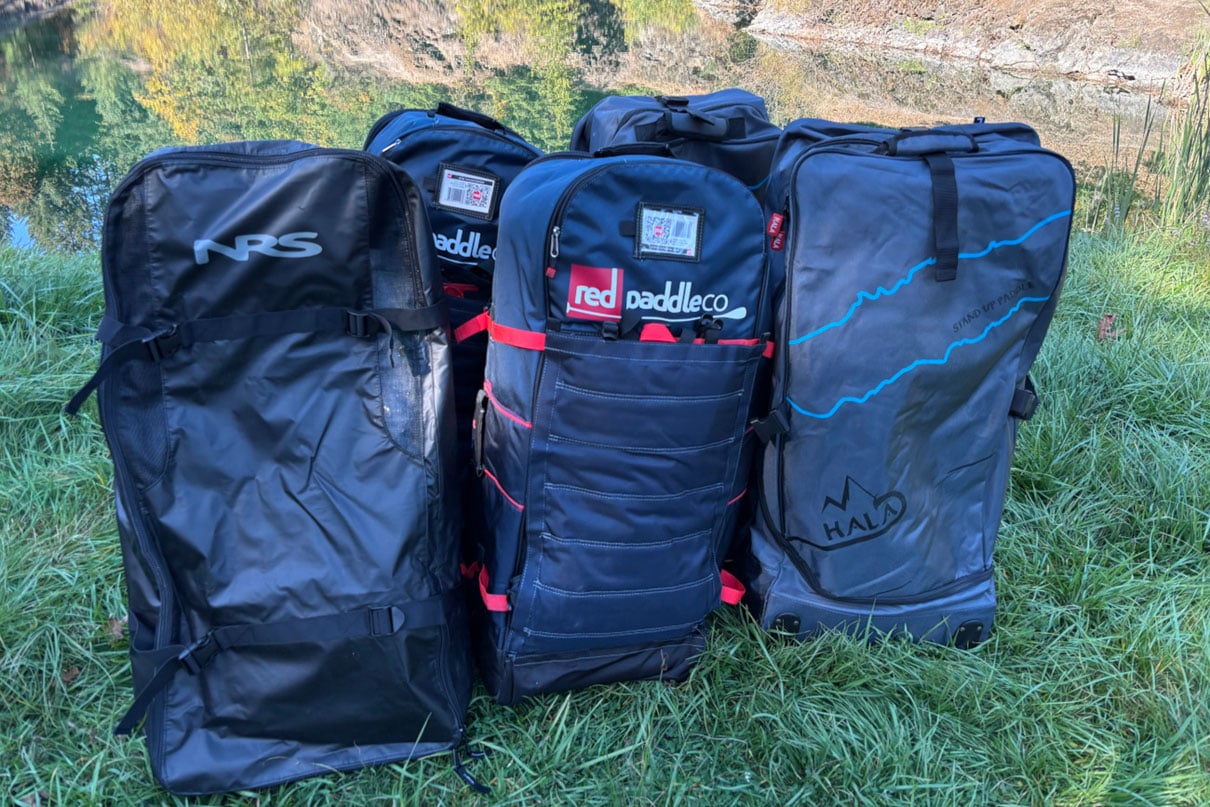
Top inflatable paddleboard brands
How we tested
We took a collection of well known and innovative inflatable paddleboards available today out on coastal wetlands, down whitewater rapids and along lakes, to put them head to head and see which performed the best in their respective categories. This testing spanned Oregon, British Columbia, and Ontario to sample a variety of waterways from the perspective of different paddlers. When making our decisions, we also considered the quality of outfitting and included accessories—bonus points for a good pump.

About the author
Joe Potoczak is a digital editor at Paddling Magazine who has been canoeing and kayaking for 25 years, and paddleboarding for about a decade. He spent years avoiding SUP, then realized what a blast it is. Now he chooses a board over his kayak most summer days.
Feature photo: Brenna Kelly



